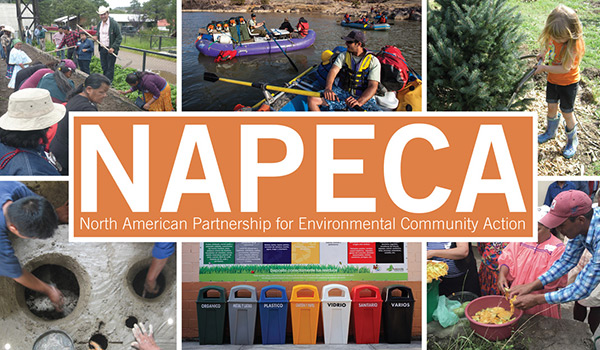Commission for Environmental Cooperation announces NAPECA grant recipients
Nine community-based environmental projects across North America to receive funding
Montreal, 27 November 2017—The Council of the Commission for Environmental Cooperation (CEC) today announced funding for nine innovative local projects under its North American Partnership for Environmental Community Action (NAPECA) grant program.
NAPECA supports small, nonprofit, nongovernmental organizations (NGOs) in Canada, Mexico and the United States that work closely with local communities and indigenous groups to create a shared sense of responsibility for stewardship of the environment.
For 2017–2018, the CEC Council members—Canada’s Minister of Environment and Climate Change Catherine McKenna, Mexico’s Secretary of the Environment and Natural Resources Rafael Pacchiano Alamán, and US Environmental Protection Agency Administrator Scott Pruitt—agreed on Innovation and Partnerships for Green Growth as the focus for the current NAPECA grant cycle. Selected initiatives will help advance environmentally responsible economic development while decreasing pressure on natural resources and promoting more sustainable patterns of production and consumption.
Work on the projects that have been awarded funding will begin in early December 2017. Projects span different North American ecoregions and support communities’ environmental efforts, from communities around Lake Winnipeg, to remote areas in Quebec, to schools in Florida, to the Mayan forests and Lake Pátzcuaro in Mexico.
A trilateral selection committee decided on nine projects from almost 300 proposals. The projects selected meet the Council’s strategic objectives to support model environmental initiatives that help build long-term partnerships to improve environmental conditions at the community, indigenous, local and regional levels. They include active community involvement, an emphasis on promoting partnerships, and a sound implementation plan with measurable objectives that can be achieved within the time-frame of NAPECA support.
The projects will be conducted by a diverse set of NGOs, environmental groups, community-based associations, academic institutions, and groups representing Tribal nations, and indigenous peoples and communities.
The NAPECA projects address such environmental issues as preventing pollution through the implementation of innovative sustainable agriculture practices for healthier land and waterway management, transferring innovative technology for community-based monitoring, and providing technical assistance for local indigenous communities to preserve and commercialize native maize species through niche markets. Others address connecting green-minded people and businesses through innovative technology, and preserving agro-ecological patterns of food production and distribution based on Traditional Ecological Knowledge. Several of the NAPECA projects are oriented toward helping tribal or indigenous communities improve their local environment.
List of NAPECA Grants for 2017-2018
| Project Name | Organization Name | Organization Country | Activity country | |
| 1 | Lake Winnipeg Waterways, Waste to Wonder | Seine-Rat River Conservation District | Canada | Canada |
| 2 | Partnerships in Indigenous-led Land-Use Planning for an Environmentally and Economically Sustainable Future | Nature Conservancy of Canada | Canada | Canada |
| 3 | Workshops for Community Involvement in the Use of Nunaliit for Environmental Applied Research in Mexico | Geomatics and Cartographic Research Centre, Carleton University | Canada | Mexico |
| 4 | Desarrollo sustentable en las comunidades indígenas P’urhépecha de la ribera del Lago de Pátzcuaro, Municipio de Pátzcuaro, Michoacán, México | Panorama Ambiental, A.C. | Mexico | Mexico |
| 5 | Building Production Capacities in Mayan Forest Communities
|
Forest Stewardship Council, A.C. (FSC A.C.) | Mexico | Mexico |
| 6 | Unidad móvil de manejo pos cosecha de maíces nativos y criollos excedentarios para su comercialización como insumo de especialidad | Identidad Cultural y Preservación de la Biodiversidad de los Maíces y otros Cultivos Criollos, A.C. | Mexico | Mexico |
| 7 | Preserving the Traditional Ecological Knowledge of First Foods and Medicines | Consultants for Indian Progress | United States | United States |
| 8 | Find Green: Connecting Green-minded People with Green-practicing Businesses | PCI Media Impact | United States | Canada, United States and Mexico |
| 9 | Bay Grasses in Classes | Tampa Bay Watch | United States | United States |

About the CEC
The Commission for Environmental Cooperation (CEC) was established in 1994 by the governments of Canada, Mexico and the United States through the North American Agreement on Environmental Cooperation, a parallel environmental agreement to NAFTA. As of 2020, the CEC is recognized and maintained by the Environmental Cooperation Agreement, in parallel with the new Free Trade Agreement of North America. The CEC brings together a wide range of stakeholders, including the general public, Indigenous people, youth, nongovernmental organizations, academia, and the business sector, to seek solutions to protect North America’s shared environment while supporting sustainable development for the benefit of present and future generations
The CEC is governed and funded equally by the Government of Canada through Environment and Climate Change Canada, the Government of the United States of Mexico through the Secretaría de Medio Ambiente y Recursos Naturales, and the Government of the United States of America through the Environmental Protection Agency.